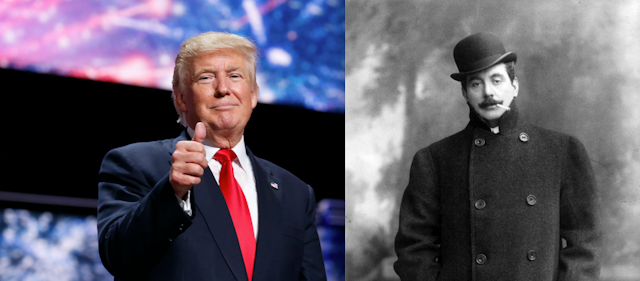Certain musicians or pieces of music, for one reason or another, will always carry unsavoury associations. Wagner, whose music was co-opted by the Nazi party, is the obvious example. The overture of his opera Die Meistersinger von Nürnberg was featured in a Nazi propaganda film. And there are many other examples of music that have been performed to great acclaim in societies that have conventionally been labelled fascist, and as a result will be seen as tainted.
Some of the composers also have questionable personal histories. Luigi Dallapiccola, for example, was an explicit fascist sympathiser at least early on in Mussolini’s regime. Arthur Honegger cultivated contacts with the German occupying forces in France and was viewed by some as a collaborator. George Enescu was a sympathiser of Octavian Goga, Romania’s fascist and fundamentalist anti-semite prime minister between 1937-38 (and who had proposed Enescu for election to the Romanian Academy in 1933), and conducted special German nationalist concerts.
But to simply label these composers’ music as “fascist” is too easy, and certainly simplistic. Some pieces have found favour in markedly non-fascistic social contexts, some strongly resemble other work produced in other types of societies or by anti-fascist or communist composers. Other composers had explicit fascist sympathies (such as Webern, who praised Mein Kampf and wrote to a friend in 1940 of his dream of a German Empire which would stretch to the Pacific, or Stravinsky), but found their work denounced or even censored by fascist politicians.
Enter Donald Trump
The “fascist music” argument reared its ugly head most recently in a Slate article in which Brian Wise argued for a fascist reading of Donald Trump’s appropriation at political rallies of Puccini’s “Nessun dorma”, an aria from the opera Turandot. The article exposes all the flaws in a too-easy labelling of certain composers or musical pieces as “fascist” and therefore unsavoury. It does so by conflating an enormous and disparate set of links and connotations into an ugly – and untenable – whole.
Part of Wise’s argument is biographical, and there’s not much to fault here. Puccini’s expression of qualified sympathy for Mussolini soon after the 1922 March on Rome is clearly documented, as is the fact that he met the dictator at least once before the composer’s death in November 1924. He also reluctantly accepted honorary Fascist Party membership and was made a senator of the realm in September 1924, a position he had coveted since before Mussolini’s assumption of power. Turandot, incomplete at the time of Puccini’s death, had a hugely successful premiere in Milan in 1926 that was attended by Mussolini, though subsequent performances were not frequent, and it would not enter the standard repertoire until a later period.
Loose associations
But Wise then quotes some very generalised statements from musicologists to back up his argument.
First there’s Arman Schwartz, who has compared the opera’s setting to Rome in the 1920s. Schwartz also identifies the relationship between virile hero and heroine to be conquered as fascistic, as well as the irrational and violent crowd. The first of these points is plausible, but the second and third are found in numerous earlier 19th century operas (such as Bizet’s Carmen, Wagner’s Siegfried, Halévy’s La Juive, Donizetti’s Les Martyrs or Verdi’s Don Carlos, to name just a few). Turandot hardly stands out on this front.
Wise then cites musicologist Alexandra Wilson’s argument that the opera’s combination of appeals to modernity and tradition makes it a “fascist emblem”. But this, too, could be said of a huge amount of music from Mozart to Brahms and well beyond.
Then there’s conductor Leon Botstein’s claim that this “regressive, narcotic, illusionistic music” provided no resistance to the regime. But evidence of musical works ever providing meaningful and productive resistance to dictatorial regimes is extremely slim. Furthermore, Botstein’s musical characterisation of Puccini’s music could equally apply to of the work of Debussy, Ravel, Szymanowski, Scriabin, Richard Strauss, Florent Schmitt and many, many others.
Wise then cites Dana Gorzelany-Mostak, who alludes to high decibel levels and themes of domination and colonialism. Once again, these are both frequent and generic aspects of operatic traditions and such classification would make huge swathes of popular music fascist.
Aria to opera
As the above litany of references makes clear, such all-encompassing fascistic interpretations of this opera are problematic, as the most intelligent recent commentator on music in fascist Italy, Ben Earle, has shown.
And all of this ignores the fact that Trump only appropriates one brief aria from this opera, and another from the earlier Gianni Schicci. Ironically, both are actually relatively conventional compared to other examples of Puccini’s volatile music. Notwithstanding their obvious passionate and sensuous qualities, the vocal writing is generally much smoother and steadier than in other more hysterical numbers or other musical passages. To read fascist implications into these arias on the basis of the rest of the operas makes little sense when there is a high likelihood that neither Trump nor his supporters will be aware of them in any case.
Research into the relationship between a long tradition of Western art, music (and for that matter, popular and non-Western musics) and fascism is vital, though far from easy. Scholars have looked in the context of fascism at musical biography, work, reception, instrumentalisation, institutions, music teaching, journalism and scholarship with subtlety and nuance. Most cogently argue that the relationship between these things and their social context is complex and multifaceted.
There may indeed be fascist dimensions to Wagner, Trump’s music preferences, or even the 1990 World Cup (where Nessun dorma also played a central role), but it requires a good deal of rigorous investigation to demonstrate this. As such, to condemn Nessun dorma on such flimsy grounds is a lazy approach to investigation of the disturbing Trump phenomenon.

